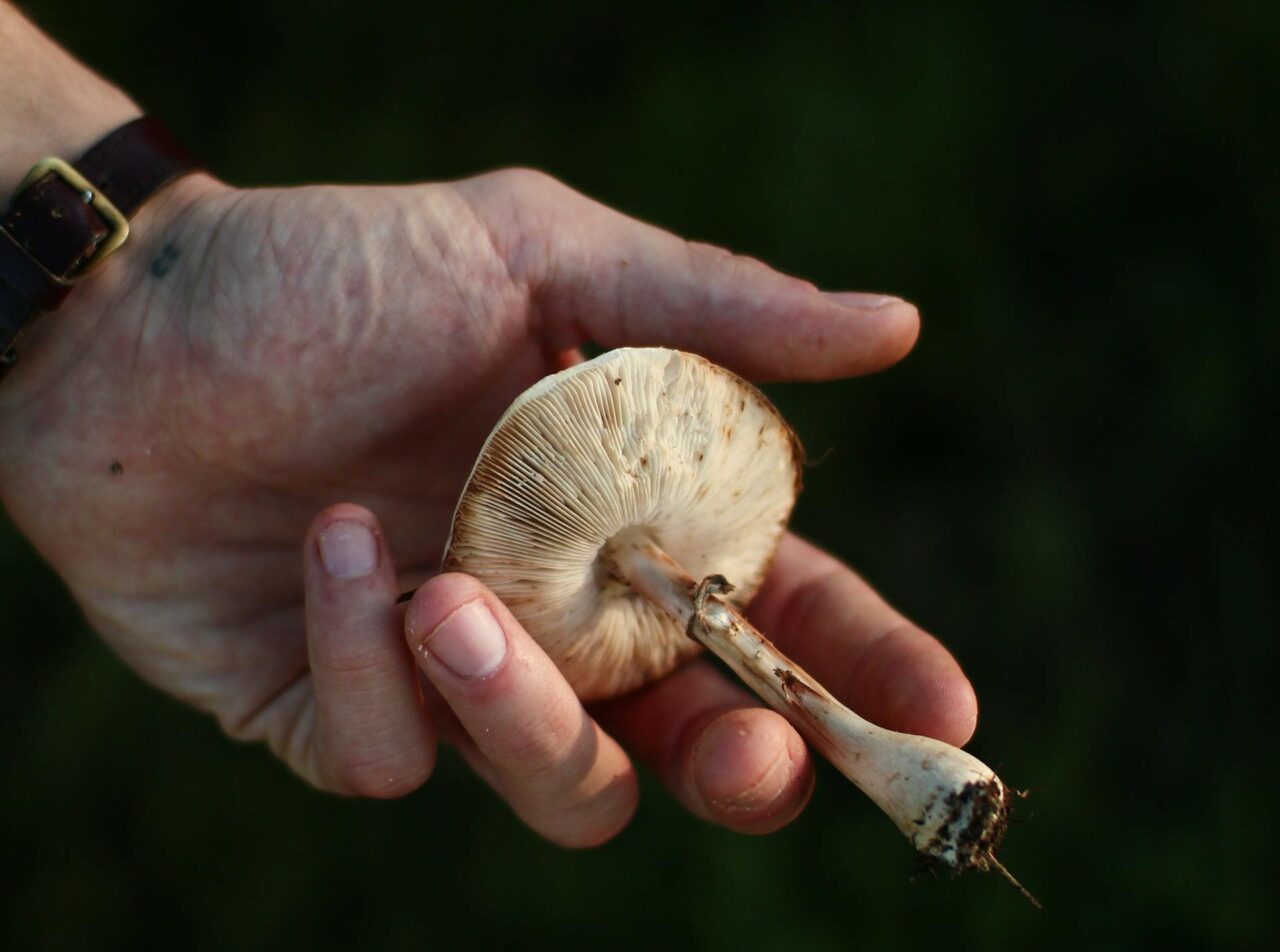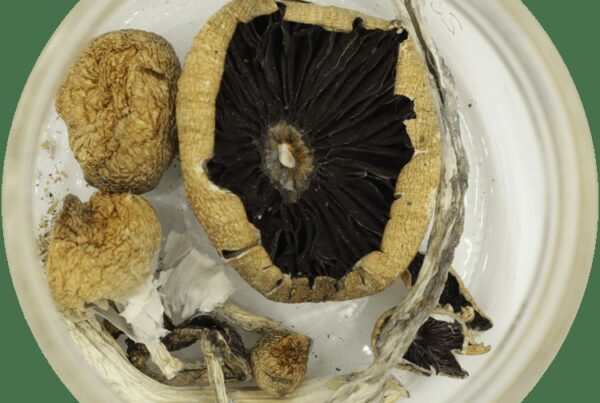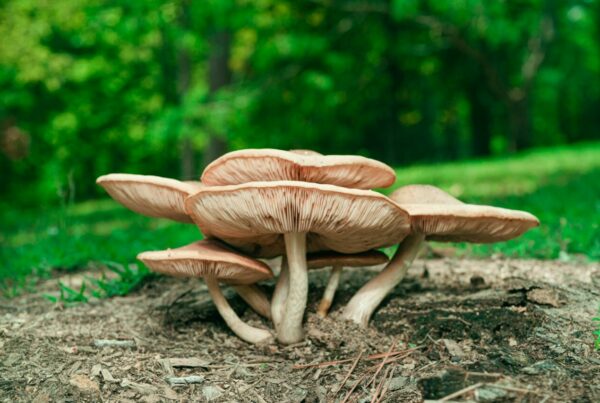Psilocybin mushrooms, a traditional psychedelic substance that acts similarly to LSD by being a serotonin 5-HT2A receptor agonist, are currently under investigation for their potential role in psilocybin-assisted treatment of mental health disorders. These disorders include major depression, anxiety, emotional distress, cluster headaches, and migraines.
To understand how shrooms can help alleviate these conditions, we must delve into how they are metabolized in the body. This knowledge aids researchers and users in discerning how the active compound produces psychological and therapeutic effects. This article serves as a basic guide to the pharmacology and pharmacokinetics of psilocybin.
[toc]
Key Takeaways:
- Half of the psychedelic fungi ingested orally gets absorbed and distributed throughout the body.
- The compound in the fungi undergoes a process called dephosphorylation, primarily in the liver, through the enzyme alkaline phosphatase.
- Around 3.4% of the compound is excreted in its unaltered state within 24 hours, with most of it being expelled as a stable metabolite.
What is Pharmacokinetics?
Pharmacokinetics (PK) is a branch of study that focuses on how substances, such as drugs, are processed by the body upon ingestion. It is closely related to, yet distinct from pharmacodynamics, which investigates how a compound interacts with the body. PK explores four main areas: absorption, distribution, metabolism, and excretion (ADME).
Knowledge of these processes equips healthcare professionals with the ability to prescribe the most effective medications with the least risk. It also helps in customizing treatment plans based on each patient’s unique physiology and lifestyle.
How Does Pharmacokinetics Relate to Psilocybin?
Psilocybin and psilocin, the main active compounds in certain magic mushroom species, have attracted significant attention from researchers and users alike. Pharmacokinetics studies how the body processes mushrooms containing psilocybin, aiding in the understanding of their potential effects, be it medicinal or recreational.
These compounds, often referred to as “magic,” “psychedelic,” “medicinal,” or “sacred,” are found in fungi that are typically consumed. The mushroom species, their place of origin, size, growth and drying conditions, and age can lead to significant differences in their potency.
While these mushrooms can be found naturally in the wild, scientists have devised techniques to synthetically produce them in a laboratory. Both the natural and synthetic versions demonstrate low toxicity, although minor side effects such as nausea or vomiting can occur.
Despite these physical side effects, the compounds present in the mushrooms exhibit potential therapeutic advantages due to their safety and non-addictive characteristics. This has led researchers to investigate their application in psychotherapy, particularly for the treatment of anxiety and depression.
Four Stages of Pharmacokinetics
Psilocybin, the compound present in these mushrooms, is inactive in its raw form and operates as a prodrug, converting into its active form, psilocin. Enzymes like alkaline phosphatase facilitate this transformation, allowing psilocin to be absorbed and distributed in the body, affecting various tissues. However, psilocybin can’t be detected in the circulatory system, feces, or urine after oral intake.
Absorption
Absorption is the process by which the compound enters the bloodstream from its point of administration. It determines the rate and effectiveness of the compound reaching its target, such as the plasma. Oral intake is the most common administration method. Although inhalation has been attempted, it is not as effective as oral consumption.
The absorption process also includes the release of the compound from the dosage form during oral ingestion. Factors such as a delay in the throat or esophagus can affect this, potentially leading to slower outcomes or causing irritation. Once the compound arrives in the stomach, the acidic environment might start to break it down before it enters the bloodstream.
Studies conducted on animals suggest that only about 50% of orally administered psychedelics are absorbed and distributed throughout the body.
Factors Affecting the Absorption Process
Several factors can influence the absorption process, leading to variations in the onset, intensity, and duration of effects:
- Stomach Contents: A full stomach can slow down the absorption process as it can delay the onset of effects. Rapid absorption is facilitated by an empty stomach.
- Body Fat: Substances may accumulate in adipose tissues, potentially prolonging their effects.
- Age: Metabolic rates and body composition are subject to change with age.
- Zero-Order Kinetics: The substance is expelled at a steady rate, regardless of its concentration.
- First-Order Kinetics: The elimination rate is directly proportional to the drug’s concentration.
Various factors such as the product’s size, polarity, and protein-binding capability, as well as the person’s physiological attributes like hydration status and body composition, greatly influence this process.
The goal is to achieve an effective concentration in the target area. For the product to work, it must reach the specified region, as dictated by the volume of distribution, and remain unbound to proteins. This allows it to actively engage with its receptor.
What Factors Affect the Distribution Process?
Several factors can influence the distribution process:
The effects usually begin to manifest around 20-40 minutes post consumption, peaking around 80-100 minutes. The impact of magic mushrooms typically lasts 4-6 hours.
How Does the Brain Receive the Distribution?
An early study conducted on two species showed that its binding affinity sequence is 5HT2A > 5HT1A > 5HT2B [23]. It also binds to dopamine D1, 5HT1E, 5HT5A, 5HT7, 5HT6, D3, 5HT2C, and 5HT1B receptors.
As a partial agonist at the 5HT2A receptor, it displays approximately 40% efficacy. Its psychedelic effects can be credited to its partial agonist activity at 5HT1A autoreceptors.
The mood-enhancing and psychotomimetic experiences could be linked to the observed correlation between increased dopamine levels and feelings of depersonalization and euphoria. Hallucinogens work by modifying neurochemistry and receptor activity. It enhances 5HT2A agonist activity by boosting BDNF synthesis in the hippocampus, which promotes neurogenesis and reduces conditioned fear-related behaviors.
Elimination
Elimination is the body’s process of removing the The human body expels a substance mainly through the kidneys, but also via the lungs, skin, or gastrointestinal tract. In the case of the kidneys, a naturally occurring psychedelic drug is filtered in the glomerulus or secreted in the tubules, adding a layer of complexity due to some reabsorption.
The primary substance has a half-life of roughly 160 minutes, while psilocin’s half-life is about 50 minutes. Animal studies indicate that the substance is primarily expelled through urine, accounting for about 65% within 8 hours. Small quantities of the substance can still be detected in the bile and feces, even after consumption.
In humans, about 3.4% of the substance is excreted in its original form within one day, while the majority is eliminated as psilocin-O-glucuronide, a more stable metabolite. This stability allows the compound to be traceable in urine samples for a longer duration.
The body primarily uses two methods to excrete substances:
Most psychedelic drugs follow the first-order kinetics method, achieving stable concentrations after four to five half-lives. Complete elimination also occurs after four to five half-lives.
Discover Our Range of Psychedelic Mushrooms
The metabolism process can differ among various types of fungi. By shopping with reliable online suppliers like Where To Buy Shrooms Canada, you can avoid ingesting poisonous mushrooms unknowingly. Some varieties, such as Agaric mushrooms, can induce intense and unpleasant effects. Hence, it’s essential to obtain magic mushrooms from trustworthy dispensaries, instead of taking risks with street vendors or wild foraging.
| Feature | Enigma | Full Moon Party | Gold Member | |
| Strain Type | Psilocybe Cubensis OMNI | Psilocybe cubensis (Thai Koh Samui) | Psilocybe cubensis | |
| Potency | Extraordinarily high; 3.8% tryptamine content | Moderate to high potency | High potency | |
| Visual Characteristics | Looks like a blob or | Resembles a cauliflower or brain in structure | Typical appearance of cubensis; of moderate size | Dense white stems; caps in a shade of golden caramel; apparent blue discoloration |
| Effects | Considered to be the most potent; generates intense effects | Potent cerebral high; onset is delayed but visuals are pronounced | Strong visual effects and sense of euphoria |
Explore Psilocybin Mushroom Usage Online
Grasping the pharmacokinetics of shrooms is crucial for medical practitioners, researchers, and users. Armed with this understanding, you can make educated decisions regarding dosage and timing, thereby reducing potential risks.
Discover your perfect psychedelic journey at Where To Buy Shrooms Canada. Whether you’re in search of a serene trip or a more profound exploration, our wide array of products is curated to meet your specific needs. Enjoy superior, safe, and quality-tested shrooms, alleviating worries about unknown sources or toxic mushrooms.
Experience the best magic mushrooms Canada has to offer and take your psychedelic journey to new heights.
Frequently Asked Questions
Are there any interactions between shrooms and other medications?
Our products may interact with certain medications, notably those affecting serotonin levels, such as SSRIs (Selective Serotonin Reuptake Inhibitors). SSRIs and SNRIs (Serotonin and Norepinephrine Reuptake Inhibitors) typically decrease the effects, unlike non-serotonergic antidepressants. This reduced effect can last up to three months following the discontinuation of the antidepressant.
Do all psychedelics operate through the same pathway as psilocybin?
No, each psychedelic substance has a unique structure that requires different metabolic processes to activate, and they bind to various receptors in the body. The administration method also affects each psychedelic’s absorption. While the basic principles of absorption, metabolism, and distribution are consistent, the specific pathways and effects vary for each substance.
Can the form of the shroom affect the pharmacokinetics?
Yes, the form (such as fresh, powdered, or dried mushrooms) can alter the absorption speed. For example, the body might absorb powdered forms faster than whole dried ones due to quicker dissolution.
Further Reading:





